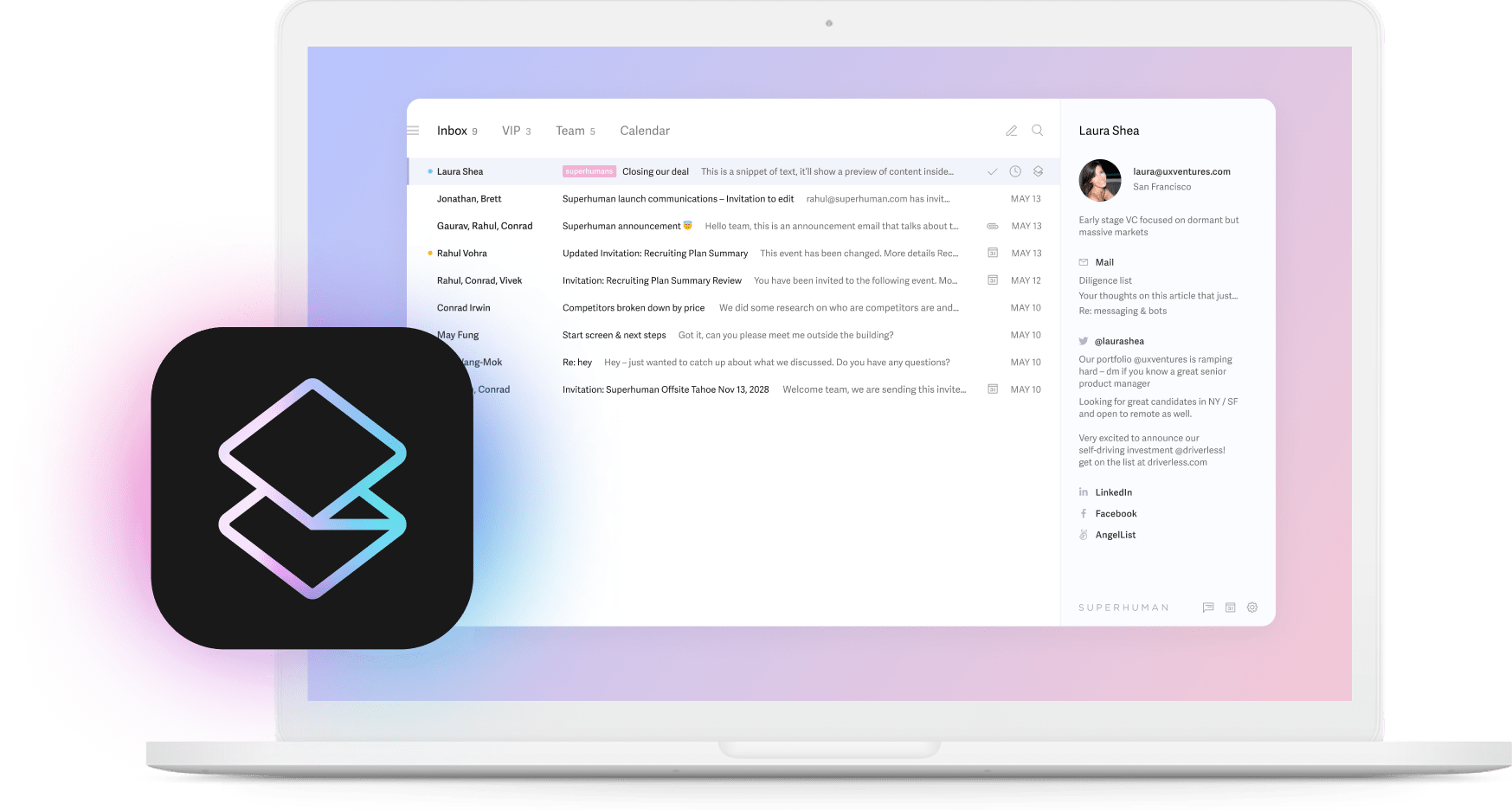
Email was designed to simplify communication, but it's become a productivity trap. Professionals now face overflowing inboxes, mental fatigue, and critical messages lost among the noise.
Enter email automation software, an intelligent solution that transforms how businesses handle communication. Today's AI-native tools do far more than send messages; they prioritize what matters, draft smart responses, and turn what was once a time-sink into a strategic advantage.
With sophisticated email automation software, teams reclaim hours of productive time while improving communication quality. By streamlining operations and reducing manual handling, these platforms free professionals to focus on high-value work that drives business forward.
The evolution of email automation software technology
Email automation software has undergone a remarkable transformation since its inception, evolving from basic functionality to sophisticated intelligence that's reshaping how we manage communications.
From basic autoresponders to intelligent email automation software systems
Early email automation software was pretty limited. It consisted of simple autoresponders that sent canned messages when triggered. These basic tools could say "thanks for your email" or "we got your form submission," but that was about it.
As technology improved, these systems got smarter, adding personalization, segmentation, and scheduling. With the help of tools and guides like this AI email writer guide, users can harness the power of AI in crafting email. Today's cutting-edge platforms like Superhuman have completely reimagined email management by using AI, machine learning, and behavior analysis.
Email marketing automation software vs. workflow automation
There's an important distinction between two main types of email automation software:
Email marketing automation software focuses on customer-facing campaigns designed to nurture leads and drive conversions. These systems typically feature campaign scheduling, A/B testing capabilities, list segmentation, and performance analytics. For insights into top email marketing software, you can explore various resources.
Workflow automation software streamlines your internal business processes and team communications. These solutions prioritize task management, document sharing, approval workflows, and internal communication efficiencies.
Though they serve different purposes, both types aim to cut manual work and boost productivity through automation.
The AI revolution in email automation software management
The biggest leap in email automation software has come through AI integration. AI for email automation enables modern platforms to go way beyond the rules-based systems of the past by offering predictive intelligence, natural language processing, learning algorithms, and smart prioritization.
This AI revolution turns email from a daily headache into a business advantage. Companies using advanced automation see much higher engagement rates and productivity gains compared to those using basic tools.
The future of email automation software is moving toward even smarter systems that don't just manage messages but provide insights and improve how you communicate. The evolution of Superhuman AI exemplifies this progression.
Measurable business impact of email automation software
When you implement email automation software, you're not just buying another tool — you're making an investment with concrete returns that directly affect your bottom line. Advanced email automation software delivers substantial improvements across key performance metrics.
Productivity & time-saving metrics
The most immediate impact of email productivity apps is getting time back. Superhuman helps teams save 4 hours per person every single week. Do the math, that's more than 200 hours saved annually per employee, essentially giving back over five weeks of productive work time.
These productivity gains come from automatic sorting and prioritization of messages, streamlined workflow management, less context switching between tasks, and elimination of repetitive email processing actions.
The benefits go beyond individual productivity. Teams respond 12 hours faster and handle twice as many email in the same amount of time.
Try SuperhumanRevenue & decision-making impact
Email automation software directly impacts your revenue-generating activities. With advanced email and marketing automation tools, organizations see faster response times to client inquiries, quicker decisions throughout the organization, and higher conversion rates on sales opportunities due to timely follow-ups.
The ROI is impressive. Research consistently shows that email automation generates an average of $38 in return for every $1 invested, making it one of your smartest business technology investments.
Psychological benefits & cognitive load reduction
Beyond the measurable productivity and revenue impacts, email automation software delivers significant psychological benefits. By enabling teams to work smarter, email automation software reduces decision fatigue, lowers mental strain, and increases satisfaction with communication workflows.
For example, high-growth technology firms implementing AI-native email tools often see a significant reduction in reported email stress levels. More importantly, teams gain more hours weekly for strategic planning rather than tactical email management.
Critical email challenges facing high-performance teams
For high-growth organizations and executive teams, email has transformed from a simple communication tool into a potential bottleneck that can impede your company's success. Let's examine the specific challenges that high-performance teams face.
Opportunity loss & decision velocity
One of the most significant challenges for executive teams is the sheer volume of critical information arriving via email. Professionals spend nearly 28% of their workday reading and responding to email.
This overwhelming influx means time-sensitive opportunities get buried in crowded inboxes, decision-making slows as key email await responses, and you lose competitive advantages when you can't respond quickly enough.
Advanced email automation software addresses this by using AI-native prioritization systems that surface the most important messages first.
Team alignment & collaboration barriers
For high-performance teams, fragmented communication creates serious alignment issues. Important conversations scatter across multiple email threads, team members have inconsistent views of customer and project status, and knowledge becomes siloed when email remains in individual inboxes.
Modern email automation software solutions solve this with collaboration tools that enable shared visibility into key conversations, delegated responses, and synchronized team inboxes.
Client relationship management challenges
Client relationships suffer when email management falters. Inconsistent response times damage client confidence, lack of visibility into previous exchanges creates disjointed experiences, and opportunities for proactive engagement get missed in inbox chaos.
Email automation software provides features like follow-up reminders, templates for consistent messaging, and relationship insights that help you maintain exceptional client experiences.
Information overload & critical signal loss
For executives and high-performance teams, the volume of email creates a critical signal-to-noise problem. Important messages get lost among promotional newsletters and routine updates, mental fatigue from processing hundreds of email leads to decreased effectiveness — a phenomenon known as inbox fatigue. Strategies to prevent inbox fatigue are essential for maintaining productivity.
AI-native email management software tools excel at filtering out noise and highlighting signals through smart categorization, automated triage, and personalized workflows that match your priorities.
Essential capabilities of modern email automation software platforms
If your team is struggling with email overload, you're not alone. Studies show that workers spend 28% of their time reading and responding to email. Today's email automation software platforms offer solutions that can dramatically transform how teams communicate, collaborate, and drive results.
Superhuman: AI-native team email automation software platform
Superhuman leads the pack with its focus on speed and efficiency through AI-native features:
Ask AI: Stop searching, start asking. Get rapid answers without remembering senders or guessing keywords.
Auto Labels: Respond faster to what matters most. Automatically classifies incoming messages using the same system as effective executive assistants.
Split Inbox: Automatically triage incoming email.
Auto Drafts: Follow up on time, every time. Automatically drafts replies to email that need follow-up.
What sets Superhuman apart is its holistic approach to email management — combining powerful automation with an intuitive interface designed to help you reach Inbox Zero quickly and stay there. For Gmail users looking for advanced features, this Gmail client guide explains how Superhuman can enhance your email experience.
Intelligent workflow automation capabilities
Modern email automation software platforms automate routine tasks to significantly boost productivity through smart categorization, automated responses, sequenced follow-ups, and behavior-based triggers.
The impact is substantial, automated email campaigns generate 87% of automated orders, with conversion rates nearly four times higher than manual email. Triggered email enjoy 32% higher open rates and 73% higher click-through rates than non-triggered messages.
Team collaboration & alignment features
Effective collaboration capabilities are essential for team-based email management. Shared inboxes allow multiple team members to manage communication from one central location. Delegation controls assign messages to team members with clear ownership and tracking.
Team Comments & Shared Threads help you collaborate faster than ever before, while activity tracking shows who has viewed or responded to shared messages.
Analytics & performance insights
Data-driven insights help teams measure efficiency and identify improvement opportunities. Response time tracking monitors how quickly your team responds to important messages. Volume analytics track email patterns to identify peak times and staffing needs.
Engagement metrics measure open rates, click rates, and responses to team communications, while productivity reporting identifies bottlenecks and optimization opportunities in email workflows.
When evaluating platforms, focus on solutions that combine powerful automation with intuitive interfaces. For comprehensive strategies on how to manage your email inbox, consider exploring in-depth guides. The right choice depends on your specific needs, but the essential capabilities outlined above should form the foundation of any modern email automation software strategy.
Leading email automation software solutions by business need
Selecting the right email automation software platform is crucial for streamlining your team's workflow and maximizing productivity. Let's explore the best solutions for specific business requirements.
For high-performance team communication
If your priority is efficiency in daily email management and team coordination:
Superhuman: The premier solution for high-performance teams. It combines a lightning-fast interface with AI-native features like smart prioritization and follow-up reminders. Its strength lies in its keyboard shortcuts and focused experience.
Front: Perfect for collaborative teams. Front merges email, apps, and teammates in a unified inbox. Its shared inbox functionality and ability to assign email make it excellent for customer-facing teams.
Shortwave: An AI-focused email client that automatically organizes your inbox into bundles and conversations. It’s designed for knowledge workers who want a smarter, more efficient approach to email organization without manual filtering.
For marketing & customer engagement
When your focus is on lead nurturing and customer communication:
Mailchimp: A versatile platform with intuitive campaign builders and robust automation workflows. It's especially effective for SMBs, offering a strong balance between power and ease of use.
ActiveCampaign: Known for its advanced automation features and CRM integration. It's a great fit for mid-market companies managing complex customer journeys.
Klaviyo: Tailored for e-commerce businesses. It integrates deeply with platforms like Shopify and WooCommerce and shines through its data-driven approach to segmentation and automation.
For customer support & service
For teams managing customer communication and support workflows:
HelpScout: Combines a shared inbox with a knowledge base, making it ideal for support teams. Collaborative tools and access to customer history improve response quality and consistency.
Zendesk: An enterprise-grade support platform with robust email, ticketing, and automation tools. Designed for larger teams with complex support needs.
Intercom: Blends real-time chat with proactive support and email follow-ups. Ideal for SaaS companies looking for a unified approach to onboarding and ongoing engagement.
For specialized industry requirements
These platforms cater to unique compliance and communication needs:
HIPAA-compliant solutions: Paubox and Virtru provide encryption and regulatory compliance for healthcare-focused organizations.
Iterable: Offers robust cross-channel marketing with strong personalization features. Ideal for enterprise retail and media companies needing coordinated communication across multiple touchpoints.
Braze: Specializes in real-time, personalized engagement across multiple channels. Best suited for large consumer brands and mobile-first companies aiming for seamless customer journeys.
Each solution brings unique strengths, whether in speed, collaboration, analytics, or integrations—helping businesses select the right fit based on their goals and workflows.
Strategic selection framework for decision-makers
Choosing the right email automation software solution requires a strategic approach that aligns with your business objectives. A systematic framework can help you evaluate options and select a platform that best fits your organization's unique needs.
Assessing strategic business priorities
Before evaluating specific solutions, clearly identify your primary business objectives. Early-stage companies may prioritize cost-effective solutions with scaling capabilities, while enterprise organizations might need robust governance features.
Determine whether your focus is on customer acquisition, retention, or support automation. Define what success looks like — whether it's improving response times, increasing conversion rates, or reducing operational costs.
When setting priorities, remember that the highest ROI comes from email automation software that addresses your most critical business challenges.
Technology ecosystem considerations
Your existing technology stack significantly impacts which email automation software solution will integrate most effectively. Ensure bidirectional data flow between your CRM and email automation platform to create a unified customer view.
Evaluate how the solution connects with your project management tools, communication platforms, and e-commerce systems. Consider industry-specific compliance needs (GDPR, CCPA, etc.) and how the automation platform addresses these requirements.
Remember that data silos can undermine the effectiveness of your email automation software. Solutions that offer pre-built integration templates can significantly reduce implementation complexity and time to value.
Team performance requirements
Assess how the solution will impact your team's workflow and effectiveness. Some platforms require significant technical knowledge, while others offer more intuitive interfaces.
Consider how the solution handles increasing volumes of email and more complex automation workflows as your business grows. Evaluate features that enable team members to work together on campaigns without duplicating efforts.
Look for platforms that balance power with usability. Tools that save time per campaign while improving email deliverability demonstrate the productivity potential of well-chosen automation.
Implementation & adoption planning
A successful deployment depends on thorough planning. Consider how quickly you need to deploy the solution and whether you have resources for a complex implementation.
Assess what level of training your team will need to effectively use the system. Plan how you'll manage the transition from manual processes to automated workflows.
Organizations that develop a structured adoption plan report significantly higher satisfaction with their automation solutions.
Conclusion: Transforming email from burden to business advantage
Email doesn't have to be the productivity drain that consumes your workday. By implementing intelligent email automation software, your team can unlock more focused, effective work through reclaimed time and enhanced focus.
Your organization benefits from accelerated decision velocity, improved team performance, and the ability to capitalize on revenue opportunities that might otherwise be missed in cluttered inboxes.
It's time to evaluate your current email processes. The right AI tools transform email into a strategic business advantage.



